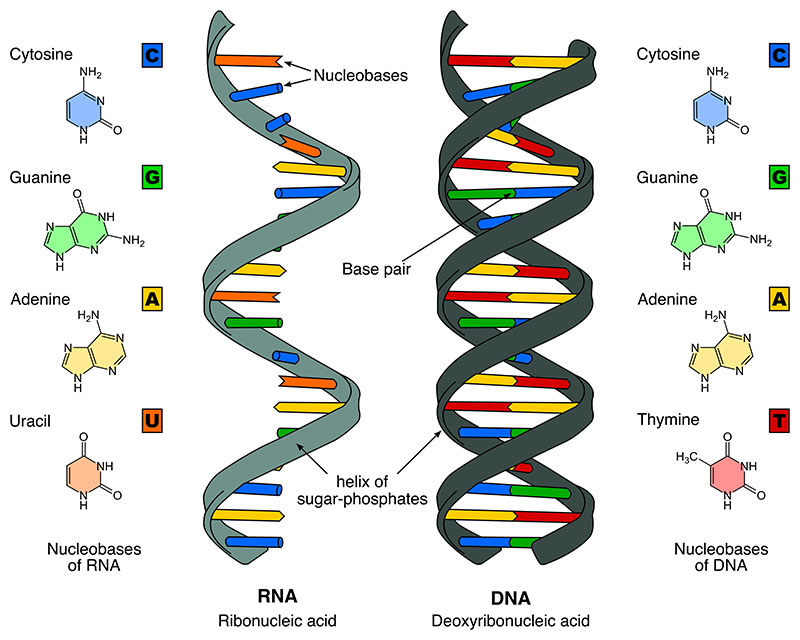DNA: The Blueprint of Life
What is DNA?
DNA, or deoxyribonucleic acid, is the hereditary material found in nearly all living organisms. It carries the genetic instructions for the development, functioning, growth, and reproduction of all known organisms and many viruses. DNA is a complex molecule that consists of two strands coiled around each other to form a double helix structure.

The Structure of DNA
The DNA molecule consists of several key components:
- Nucleotides: DNA is composed of four types of nucleotide building blocks – adenine (A), thymine (T), guanine (G), and cytosine (C). Each nucleotide consists of a phosphate group, a sugar group (deoxyribose), and one of the four nitrogenous bases.
- Sugar-Phosphate Backbone: The sugar-phosphate backbone forms the structural framework of DNA. The phosphate groups and sugar molecules alternate to create the sides of the "ladder," while the nitrogenous bases form the "rungs."
- Base Pairing: The two strands of DNA are held together by hydrogen bonds between the nitrogenous bases. Adenine (A) always pairs with thymine (T), and guanine (G) always pairs with cytosine (C). This complementary base pairing is a crucial aspect of DNA's structure and function.
The Central Dogma of Molecular Biology
The central dogma of molecular biology describes the flow of genetic information within a biological system. It states that the genetic information encoded in DNA is transcribed into RNA, which is then translated into proteins. This process is essential for the proper functioning and survival of all living organisms.
Replication
DNA replication is the process by which the DNA molecule makes an exact copy of itself during cell division. The double helix unwinds, and each strand serves as a template for the synthesis of a new complementary strand. DNA polymerase enzymes facilitate this process, ensuring accurate copying of the genetic information.
Transcription
Transcription is the process by which the genetic information in DNA is copied into a complementary RNA strand. RNA polymerase enzymes read the DNA sequence and synthesize messenger RNA (mRNA) molecules, which carry the genetic information to the ribosomes for protein synthesis.
Translation
translation is the process by which the genetic information in mRNA is used to synthesize proteins. Ribosomes read the genetic code in mRNA and translate it into a sequence of amino acids, which fold into functional proteins. Transfer RNA (tRNA) molecules play a crucial role in this process by delivering the appropriate amino acids to the ribosome.
The Genetic Code
The genetic code is the set of rules that defines how the information encoded in DNA is translated into proteins. The code consists of 64 codons, each composed of three nucleotides (a triplet). Each codon specifies a particular amino acid or a stop signal. The genetic code is nearly universal across all living organisms, with only minor variations in some species.
DNA Mutation and Repair
DNA mutations are changes in the nucleotide sequence of the DNA molecule. Mutations can occur spontaneously due to errors during DNA replication or as a result of exposure to mutagens (e.g., UV radiation, certain chemicals). While some mutations have no effect on the organism, others can be harmful or even beneficial.
To maintain the integrity of the genetic information, cells have evolved various DNA repair mechanisms. These mechanisms can detect and correct different types of DNA damage, such as base mismatches, single-strand breaks, and double-strand breaks. DNA repair is essential for preventing the accumulation of mutations that could lead to genetic disorders or cancer.
Applications of DNA in Biotechnology
The understanding of DNA's structure and function has revolutionized the field of biotechnology. Some key applications include:
Genetic Engineering
Genetic engineering involves the manipulation of an organism's DNA to introduce new traits or modify existing ones. This technology has been used to create genetically modified crops with improved yield, resistance to pests, and enhanced nutritional value. In medicine, genetic engineering has led to the development of recombinant proteins (e.g., insulin) and gene therapies for treating genetic disorders.
DNA Sequencing
DNA sequencing is the process of determining the precise order of nucleotides in a DNA molecule. Advances in DNA sequencing technologies, such as next-generation sequencing (NGS), have greatly accelerated genomic research. DNA sequencing has numerous applications, including the study of evolutionary relationships, the identification of disease-causing mutations, and the development of personalized medicine.
Forensic Science
DNA analysis has become a powerful tool in forensic science. DNA fingerprinting, which involves comparing DNA samples from a crime scene with those of suspects, has helped solve countless criminal cases. DNA evidence can also be used to establish paternity, identify human remains, and exonerate wrongfully convicted individuals.
Further Reading
Nature Reviews Chemistry, DNA synthesis technologies to close the gene writing gap
Annual Review of Biochemistry, DNA Replication and Transcription in Mammalian Mitochondria
